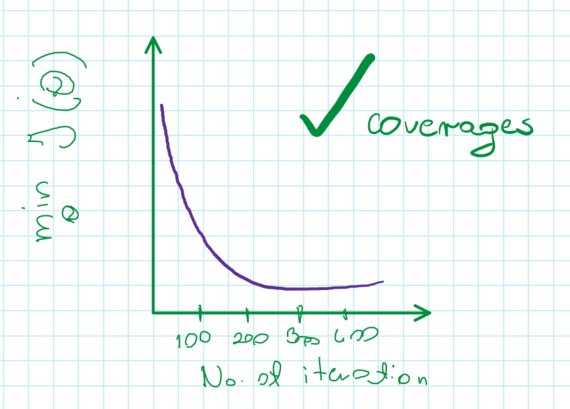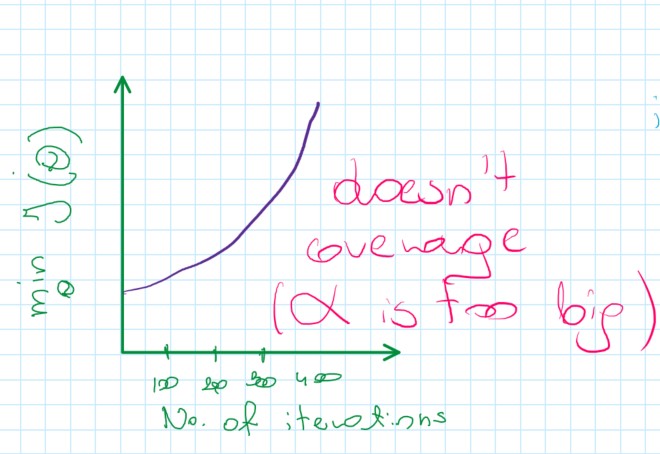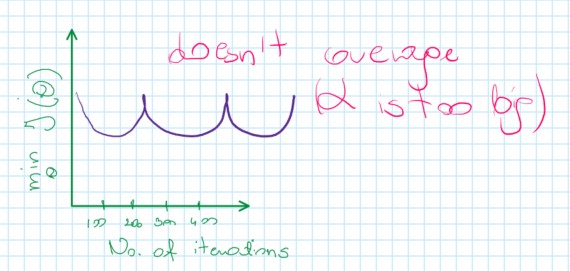
My notes from the Machine Learning Course provided by Andrew Ng on Coursera
Linear Regression with Multiple Variables
Linear Regression for a single feature
h_θ(x)=θ_0+θ_1 x
Linear Regression for multiple variables
h_θ(x)=θ_0x_0+θ_1x_1+θ_2x_2+...+θ_nx_n
where x_0=1
Parameters: θ=\{θ_0,θ_1,θ_2,...,θ_n\} \in \R^{n+1}
Features: x=\{x_0,x_1,x_2,...,x_n\} \in \R^{n+1}
Notation:
n– number of featuresx^{(i)}– input (features) ofi^{th}training examplex_j^{(i)}– values of featurejini^{th}training example
Example:
Predict house price:
Size (feet^2) |
No. of bedrooms | No. of floors | Age of house (years) | Price($1000) |
|---|---|---|---|---|
\textcolor{#c91862}{x_1} |
\textcolor{#c91862}{x_2} |
\textcolor{#c91862}{x_3} |
\textcolor{#c91862}{x_4} |
\textcolor{#c91862}{h_θ(x)=y} |
| 2104 | 5 | 1 | 45 | 460 |
| 1416 | 3 | 2 | 40 | 232 |
| 1534 | 3 | 2 | 30 | 315 |
| 852 | 2 | 1 | 36 | 178 |
n=4
x^{(i)}:
x^{(2)}=\begin{bmatrix} 1416 \\ 3 \\ 2 \\ 40 \end{bmatrix}
x^{(4)}=\begin{bmatrix} 852 \\ 2 \\ 1 \\ 36 \end{bmatrix}
Vector is \R^n \Rightarrow \R^4
x_j^{(i)}:
x_1^{(2)}=1416; x_2^{(2)}=3; x_3^{(2)}=2; x_4^{(2)}=40;
x_1^{(4)}=852; x_2^{(4)}=2; x_3^{(4)}=1; x_4^{(4)}=36;
so hypothesis function will use like below:
h_θ(x)=θ_0+2140 θ_1 + 5 θ_2 + θ_3 + 45 θ_4 = 460
h_θ(x)=θ_0+1416 θ_1 + 3 θ_2 + 2 θ_3 + 40 θ_4 = 232
h_θ(x)=θ_0+1534 θ_1 + 3 θ_2 + 2 θ_3 + 30 θ_4 = 315
h_θ(x)=θ_0+852 θ_1 + 2 θ_2 + θ_3 + 36 θ_4 = 178
Cost Function
J(θ)=\frac{1}{2m} \displaystyle\sum_{i=1}^m (h_θ (x^{(i)})-y^{(i)})^2
where
(h_θ (x^{(i)})-y^{(i)})^2 – Square Error of data i
h_θ (x^{(i)}) – Predicted value
y^{(i)} – True value
The function is called Mean Error Square (MSE)
Gradient Descent
Repeat {
θ_j := θ_j - \alpha \frac{∂}{∂θ_j} J(θ)
}
(simultanously uptae for every j=0,...,n)
Pseudocode for gradient descent
1) n=1 (only one variable)
repeat until convergence {
θ_0 := θ_0 - \alpha \frac{1}{m} \displaystyle\sum_{i=1}^m (h_θ (x^{(i)} )-y^{(i)})
θ_1 := θ_1 - \alpha \frac{1}{m} \displaystyle\sum_{i=1}^m (h_θ (x^{(i)} )-y^{(i)})x^{(i)}
} simonously update θ_0, θ_1
2) n\geqslant1
repeat until convergence {
θ_j := θ_j - \alpha \frac{1}{m} \displaystyle\sum_{i=1}^m (h_θ (x^{(i)} )-y^{(i)})x_j^{(i)}
} simonously update θ_j for j = 0,...,n
Example for more than two features
θ_0 := θ_0 - \alpha \frac{1}{m} \displaystyle\sum_{i=1}^m (h_θ (x^{(i)} )-y^{(i)})x_0^{(i)}
and becausex_0^{(i)}=1this pseudocode forθ_0parameter can be written:
θ_0 := θ_0 - \alpha \frac{1}{m} \displaystyle\sum_{i=1}^m (h_θ (x^{(i)} )-y^{(i)})θ_1 := θ_1 - \alpha \frac{1}{m} \displaystyle\sum_{i=1}^m (h_θ (x^{(i)} )-y^{(i)})x_1^{(i)}θ_2 := θ_2 - \alpha \frac{1}{m} \displaystyle\sum_{i=1}^m (h_θ (x^{(i)} )-y^{(i)})x_2^{(i)}
Gradient Descent in Practice
Idea: Make sure features are on a similar scale, so gradient descent coverages fast
Example:
x_1 = size (0-2000 feet^2)
x_2 = number of bedrooms (1-5)
Problem:
The x_1 have a larger range of values than x_2, so J(θ) can write very skewed elliptical shape and gradient descent on this cost function may end up with a long time of execution.
Feature Scaling
Feature scaling involves dividing the input values by the range (i.e. the maximum values minus the minimum value) of the input variable, resulting in a new range of just 1
x_1 = \frac{size(feet^2)}{2000}
x_2 = \frac{no. of bedrooms}{5}
new tange for this example:
0 \leqslant x_1 \leqslant 1
0 \leqslant x_2 \leqslant 1
The scale for the features should be approximately a \textcolor{#c91862}{-1 \leqslant x_i \leqslant 1} range
Mean Normalization
Replace x_i with x_1 - \mu_1 to make features have approximetley zero mean (don’t do for x_0=1)
Example:
x_1 = \frac{size-1000}{2000} (where average = 1000 and max=2000)
x_2 = \frac{no. of bedrooms - 2}{5} (where average = 2 and max = 5)
The new range is:
-0.5 \leqslant x_1 \leqslant 0.5
-0.5 \leqslant x_2 \leqslant 0.5
x_i = \frac{x_i-\mu_i}{s_i} where \mu_i = average of x in training set and s_i = range (max - min) or standard derivation
Learning Rate \alpha
"Debugging" – how to make sure gradient descent is working correctly.
Plot min value of cost function after some number of iterations.
It’s difficult to tell how many iterations cost function need to coverage.
The function works correctly because J(\theta) decrease after each iterration:
In below example, the function is flattened and (less or more) the function is coverage as a cost function

If J(\theta) increasing, probably it should use smaller \alpha


Automatic coverage test
Example: Declare coverage if J(\theta) decreases by less then the small value (10^{-3}) in one iteration.
Summary
- for sufficiently small
\alpha,J(\theta)should decrease on each iteration - if
\alphais too small: slow coverage - if
\alphais too large:J(\theta)may not decrease on every iteration; may not coverage - find best
\alphafor speed + convergence by ploting different\alphavalues, e.g.0.01, 0.03, 0.1, 0.3...
Features and Polynomial Regression
Understanding features can allow us to create a better model e.g. by combining them:
x_1 = width
x_2 = depth
h_\theta(x)=\theta_0 + \theta_1 x_1 + \theta_2 x_2
\rightarrow combine to area
area = width * depth
x = x_1 * x_2
so
h_\theta(x) = \theta_0 + \theta_1 x (using only one feature)
Polynomial regression
Hypothesis function doesn’t need to be a straight line.
It can be polynomial by choosing features
The hypothesis function can change into quadratic, cubic or square root function (or any other form)
e.g.
hypothesis function: h_\theta(x) = \theta_0 + \theta_1 x_1
- create an additional feature based on
x_1
h_\theta(x) = \theta_0 + \theta_1 x_1 + \theta_2 x_1^2 (quadratic function)
or
h_\theta(x) = \theta_0 + \theta_1 x_1 + \theta_2 x_1^2 + \theta_3 x_1^3 (cubic function)
The feature scaling is very important!
e.g. if x_1 has range 1-1000 than range of x_1^2 becomes 1-100 000 and x_1^3 becomes 1 - 100 000 000
Normal Equation
Normal equation – Method to solve \theta analytically \rightarrow finding the optimal value in just one go
Intuition: If 1D (\theta \in \R)
Cost function: J(\theta) = a\theta^2 + b\theta+c (quadratic function)
Solve for minJ(\theta) \rArr (\theta_0, \theta_1, ..., \theta_n)
- take the derivetives with respect to the
\theta'sand set them to 0 \theta \in \R^{n+1}J(\theta_0,\theta_1,...,\theta_m) = \frac{1}{2m}\displaystyle\sum_{i=1}^m (h_\theta (x^{(i)})-y^{(i)})^2
\frac{\partial}{\partial \theta_j} J(\theta) = ... = 0 (for every j)
Example: m = 4 (House price prediction)
Size (feet^2) |
No. of bedrooms | No. of floors | Age of house (years) | Price($1000) |
|---|---|---|---|---|
\textcolor{green}{x_1} |
\textcolor{green}{x_2} |
\textcolor{green}{x_3} |
\textcolor{green}{x_4} |
\textcolor{green}{y} |
| 2104 | 5 | 1 | 45 | 460 |
| 1416 | 3 | 2 | 40 | 232 |
| 1534 | 3 | 2 | 30 | 315 |
| 852 | 2 | 1 | 36 | 178 |
\Darr
Add extra column that corresponds to extra feature x that always takes value of 1
Size (feet^2) |
No. of bedrooms | No. of floors | Age of house (years) | Price($1000) | |
|---|---|---|---|---|---|
\textcolor{#c91862}{x_0} |
\textcolor{green}{x_1} |
\textcolor{green}{x_2} |
\textcolor{green}{x_3} |
\textcolor{green}{x_4} |
\textcolor{green}{y} |
\textcolor{#c91862}{1} |
2104 | 5 | 1 | 45 | 460 |
\textcolor{#c91862}{1} |
1416 | 3 | 2 | 40 | 232 |
\textcolor{#c91862}{1} |
1534 | 3 | 2 | 30 | 315 |
\textcolor{#c91862}{1} |
852 | 2 | 1 | 36 | 178 |
so:
note
a+b+c
\underbrace{X}_{\text{features}} = \underbrace{\begin{bmatrix} 1 & 2104 & 5 & 1 & 45 \\ 1 & 1416 & 3 & 2 & 40 \\ 1 & 1534 & 3 & 2 & 30 \\ 1 & 852 & 2 & 1 & 36 \end{bmatrix}}_{\textcolor{#c91862}{\text{m x (n + 1)}}}
y = \underbrace{\begin{bmatrix} 460 \\ 232 \\ 315 \\ 178 \end{bmatrix}}_{\textcolor{#c91862}{\text{m - dimensional vector}}}
Than:
\theta = (X^TX)^{-1}X^Ty (normal equation)
In general case:
mexamples(x^{(1)}, y^{(1)}), ... , (x^{(m)}, y^{(m)})
x^{(i)} = \underbrace{\begin{bmatrix} x_0^{(i)} \\ x_1^{(i)} \\ x_2^{(i)} \\ \vdots \\ x_n^{(i)} \end{bmatrix}}_{\textcolor{#c91862}{\text{vector of all features values in the example}}} \in \R^{n+1}
Design matrix:
X = \underbrace{\begin{bmatrix} --- & (x^{(1)})^T & --- \\ --- & (x^{(2)})^T & --- \\ \vdots \\ --- & (x^{(m)})^T & --- \\ \end{bmatrix}}_{\textcolor{#c91862}{\text{m x (n + 1)}}}
E.g.
If x^{(i)} = \begin{bmatrix} 1 \\ x_1^{(i)} \end{bmatrix}
X = \begin{bmatrix} 1 & x^{(1)} \\ 1 & x_2^{(1)} \\ \vdots \\ 1 & x_m^{(1)} \end{bmatrix}
\vec{y} = \begin{bmatrix} y^{(1)} \\ y^{(2)} \\ \vdots \\ y^{(m)} \end{bmatrix}
\theta = (X^TX)^{-1}X^Ty
where:
(X^TX)^{-1} – is inverse of matrix X^TX
No need to do a feature scaling
Gradient Descent vs Normal Equation
for m training examples and n features
| Gradient Descent | Normal Equation |
|---|---|
Need to choose \alpha |
No need to choose \alpha |
| Needs many iterations | Don’t need to iterate |
\mathcal{O}(kn^2) |
Need to compute (X^TX)^{-1} \Rightarrow \mathcal{O}(n^3) |
Works well even when n is large |
Slow if n is very large |
What if X^TX is non-invertible?
Non-invertible X^TX:
- singular
- degenerate
If X^TX is non-invertible – there are usually two common causes for this:
1) Redundant features (linear dependent)
E.g. x_1 = \text{size in } feet^2
x_2 = \text{size in } m^2
2) Too many features (e.g. m \leqslant n)
delete features or use some regularization
